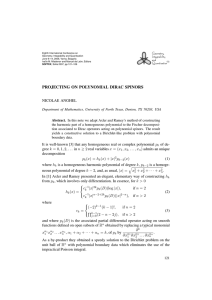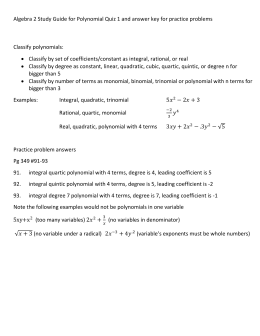
Polynomial Functions Study Guide
A playful, readable, and thorough guide to precalculus, this bookis directed at readers who would like a holistic look at the highschool curriculum material on functions and their graphs. Tantonprovides a coherent guided tour of exploration and discovery of a richmathematical landscape. The exploration is presented through problemsselected from the history of the Mathematical Association of America'sAmerican Mathematics Competition (AMC).Secondary school teachers looking for supplementary and enrichmentmaterials will find this a rich resource, which aligns with nationalcurriculum standards. High school and college calculus andprecalculus students will discover an approachable andthought-provoking review, preview, and overview of these centralmathematical ideas. Students preparing for the AMC should find itespecially helpful. Active reading, with pencil in hand, will resultin a deep appreciation and understanding of the properties offunctions.James Tanton is the MAA's mathematician-at-large. A researchmathematician with experience teaching at both the college and highschool levels, he now works to encourage and aid all mathematicsinstructors to teach—and all mathematics students tolearn—joyously and effectively.ReadershipUndergraduate students interested in teaching secondarymathematicis, high school-level contest problems, and math circles forteachers.Reviews & Endorsements.
Abstract:A playful, readable, and thorough guide to precalculus, this bookis directed at readers who would like a holistic look at the highschool curriculum material on functions and their graphs. Tantonprovides a coherent guided tour of exploration and discovery of a richmathematical landscape. The exploration is presented through problemsselected from the history of the Mathematical Association of America'sAmerican Mathematics Competition (AMC).Secondary school teachers looking for supplementary and enrichmentmaterials will find this a rich resource, which aligns with nationalcurriculum standards. High school and college calculus andprecalculus students will discover an approachable andthought-provoking review, preview, and overview of these centralmathematical ideas. Students preparing for the AMC should find itespecially helpful. Active reading, with pencil in hand, will resultin a deep appreciation and understanding of the properties offunctions.James Tanton is the MAA's mathematician-at-large. A researchmathematician with experience teaching at both the college and highschool levels, he now works to encourage and aid all mathematicsinstructors to teach—and all mathematics students tolearn—joyously and effectively.
A polynomial is an expression of one variable of the form a n x n + a n-1 x n-1 +. Gl golf for mac. + a 2 x 2 + a 1 x + a 0, where a n, a n-1, a 1, a 0 are real numbers, n is a positive integer, and a n≠ 0. Thedegree of a polynomial is n. A n, a n-1, a 1, a 0 are thecoefficients of the polynomial. A n is the leading coefficient, and a 0is the constant term. A n x n, a n-1 x n-1, a 2 x 2, a 1 x, a 0are the terms of the polynomial.
There are n + 1 terms in a polynomial ofdegree n.A polynomial function is any function which is a polynomial; that is, it isof the form f ( x) = a n x n + a n-1 x n-1 +. + a 2 x 2 + a 1 x + a 0.The roots of a polynomial function are the values of x for which thefunction equals zero. Roots are also known aszeros, x-intercepts, and solutions. All of these terms are synonymous. Oneof the most important things to learn about polynomials is how to find theirroots.Polynomial functions have special names depending on their degree. A polynomialfunction of degree zero has only a constant term - no x term. If theconstant is zero, that is, if the polynomial f ( x) = 0, it is called the zeropolynomial.
A summary of Polynomials in 's Polynomial Functions. Learn exactly what happened in this chapter, scene, or section of Polynomial Functions and what it means. Perfect for acing essays, tests, and quizzes, as well as for writing lesson plans.

If the constant is not zero, then f ( x) = a 0, and thepolynomial function is called a constant function. If the polynomialfunction has degree one, then it is of the form f ( x) = ax + b, and is called alinear function. If the polynomial is of degree two, then it is of the formf ( x) = ax 2 + bx + c, and is called a quadratic function. In the nextsection, we'll learn more about quadratic functions.